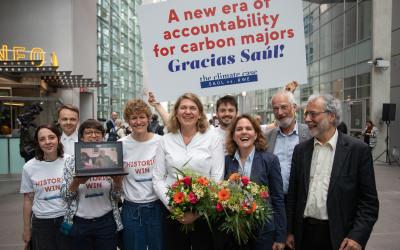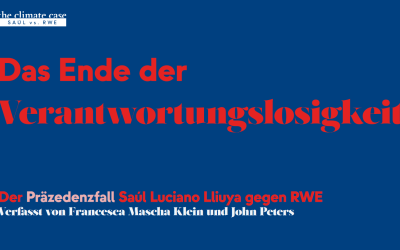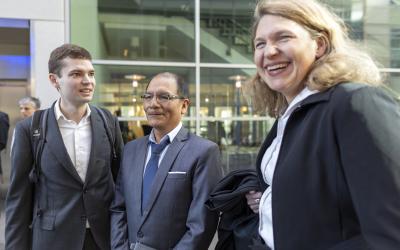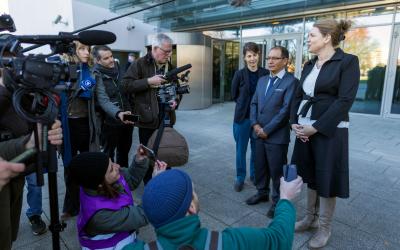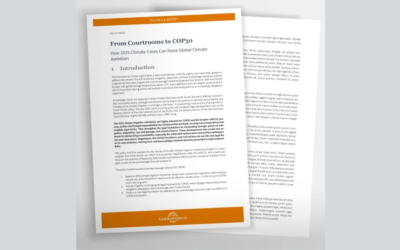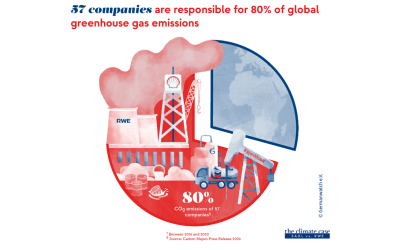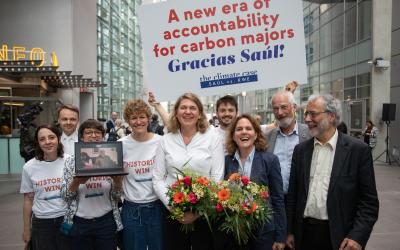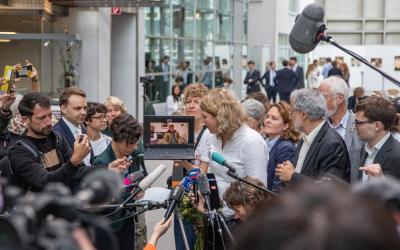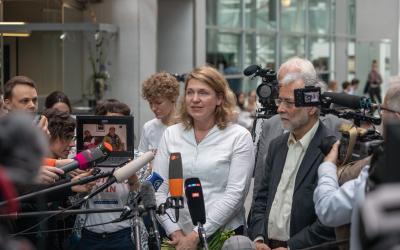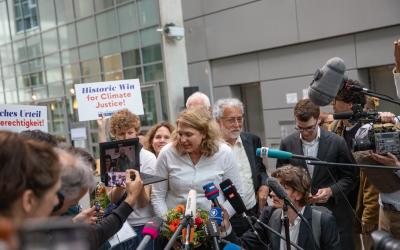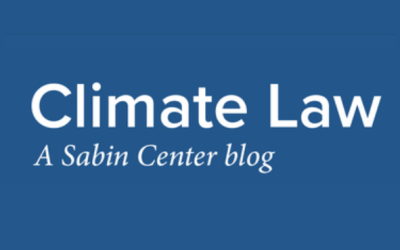Press
Historical Judgement May 28, 2025
Find our press release on the court´s decision below.
More infos about the proceeding in our timeline.
You can find all the important points of the verdict in our summary.
Our analysis "New era of accountability. The precedent case of Saúl Luciano Lliuya v. RWE"
Here you can find the full written verdict. (unofficial translation)
Press releases
Aktuelles
Climate lawsuit Saúl vs RWE: “A historic ruling that can serve as a guide for courts around the world” – Interview
In principle, large emitters can be held accountable for climate risks. This was the ruling handed down by the Higher Regional Court on May 28 in the climate lawsuit brought by Saúl Luciano Lliuya against RWE. The court has thus made legal history. However, Saúl’s lawsuit was dismissed because the court did not consider the flood risk to his property to be sufficiently high. Francesca Mascha Klein, legal advisor for strategic litigation, has accompanied the proceedings and explains in this interview why the ruling is an important precedent.
read moreNew era of accountability
The ruling by the Hamm Higher Regional Court in the Lliuya v. RWE case has made legal history. For the first time, a German court has recognized that a company can be held liable under civil law for its contribution to the global climate crisis - even across national borders. Here you can read all the important legal points from the judgment of May 28, 2025.
read moreGroundbreaking climate ruling against RWE: Major emitters can be held liable for climate risks
Saúl Luciano Lliuya v. RWE: Judges at the Higher Regional Court of Hamm have ruled that German civil law can be used to hold major emitters liable for the effects of climate change — a decision that extends protection to those impacted worldwide.
read moreGerman court on the brink of holding major emitters liable for climate damages
The Higher Regional Court of Hamm has concluded hearings in landmark climate case of the Peruvian farmer Saúl Luciano Lliuya’s case against German energy company RWE, with a decision expected on May 28th.
read moreMaterial
Here you will find press photos in printable quality as well as other material for your reporting. The material may be used free of charge provided that the corresponding reference (which can be found under the respective entry) is mentioned .
Materials
Webinar: The Saúl vs. RWE Decision
|
Why is the judgement in the RWE case historic? What does the decision mean for climate litigation and people affected by climate change?
Plaintiff Saúl Luciano Lliuya, lawyer Roda Verheyen, Christoph Bals from Germanwatch and Noah Walker-Crawford, Research fellow at the Grantham Research Institute give first insights into the judgement.
FAQs
FAQ
In the opinion of the Civil Senate, it could not be proven in the specific case that there was a sufficiently high probability that Saúl Luciano Lliuya's property would be affected by a glacial flood.
The court followed the expert opinion on the flood risk submitted by the court experts in the summer of 2024, which was the focus of the hearing in March 2025. The court experts estimated the probability of a glacial lake outburst flood (GLOF) reaching Saúl Luciano Lliuya's property in the next thirty years at one percent. The experts based their findings on events from the past and applied them to the future. In doing so, they ignored rockfalls as a trigger for a flood wave and the fact that these are occurring more and more frequently as the climate crisis continues.
The Intergovernmental Panel on Climate Change (IPCC) assumes that the probability of events leading to glacial lake outbursts in high mountain regions (and especially in the Andes) will increase in the future; in particular, it is expected that the melting of permafrost will make glaciers and mountains more unstable and large rockfalls more likely. The plaintiff side, together with experts from the fields of climate and glacier science, had submitted their own expert reports on the risk of rockfalls and included the consequences of climate change in their calculations. They came to the conclusion that the probability of a GLOF occurring in the next thirty years is thirty percent.
The verdict is a great success despite the dismissal of the case. This is because it is the first time that a higher court in Europe has established that major emitters can be held liable for the consequences of climate change under German civil law. This is a historic landmark ruling that can be applied by those affected in many places around the world. The judges have determined that Section 1004 of the German Civil Code (so-called “neighborhood provision”) is also applicable to the climate crisis and transnational contexts, as in the case of RWE (based in Essen, Germany) and Saúl Luciano Lliuya (resident in Huaraz, Peru). Similar legal provisions exist in more than fifteen other countries, such as the Netherlands, Switzerland and Japan. Courts are increasingly deciding that companies have a responsibility in the face of the climate crisis (for example in a court case in the Netherlands against Shell) and at the same time the findings of climate science are becoming ever more precise. The chances of success for those affected who want to hold major emitters accountable in court are higher than ever before. Saúl Luciano Lliuya's lawsuit was not just about himself and winning an individual case, but about strengthening the rights of all people exposed to the dangers of the climate crisis against those responsible. He has succeeded in doing so.
With its ruling in the RWE case, the Higher Regional Court of Hamm has made an important fundamental decision that has an impact far beyond the individual case: it has legally established that large emitters can be held responsible for the consequences of climate change. Court rulings play a central role in the interpretation of the law and decision-making. It opens doors for those affected by the climate crisis to take legal action against large emitters (see FAQ above). However, the arguments of the Higher Regional Court of Hamm will also have an impact beyond the courtroom and shape the public and political discourse on the question of the extent to which an overall mechanism for holding large emitters accountable for their costs is necessary.
The ruling increases the pressure on companies in the fossil fuel industry: the decision that they can generally be held liable for climate impacts means that their fossil fuel business models are subject to legal and therefore also financial risk. Major emitters must now include these potential costs in their calculations. If fossil fuel companies can no longer pass on the consequences of their business models to the state and those affected, this will call their profitability into question. The ruling therefore also sends a clear message to the financial markets that fossil fuel investments have no future.
Courts are there to apply the law in individual cases and make appropriate decisions. Politicians, on the other hand, have a responsibility to recognize structural problems that are revealed within the framework of individual proceedings and to respond with appropriate measures. In the course of these proceedings, a problem became apparent that goes far beyond this specific case: instead of the companies that have profited from climate-damaging business models for decades, it is currently individual affected parties and, in some cases, countries with comparatively low historical emissions that are bearing the major burden of the costs of the climate crisis.
We now urgently need regulations at national and international level that set out clear obligations for those responsible for the climate crisis. For political decision-makers: the momentum is there to create a clear legal framework, distribute the cost of climate impacts fairly and prevent further damage. If this does not succeed, corporations will have to operate with the constant risk of legal liability - and those affected worldwide will go to court with their backs strengthened.
Together with his lawyer, Dr. Roda Verheyen, Saúl will analyze the ruling of May 28 2025 in his climate lawsuit against RWE and examine further legal steps.
Together with the local NGO Wayintsik- Perú and the initiative “Salvemos los Andes”, he will inform his community about the significance of the verdict he has achieved and continue to raise awareness about the climate crisis and the role and responsibility of large emitters.
Germanwatch and the Stiftung Zukunftsfähigkeit will remain in contact with the plaintiff and the NGO Wayintsik Perú and will do everything possible to ensure that protective measures are implemented at the Palcacocha glacial lake.
Saúl Luciano Lliuya continues to work as a mountain guide and organizes mountain tours in the region for tourists. His family cultivates a piece of land outside the city to grow vegetables and keep animals. Saúl will continue to pursue these activities in the future.
The threat posed by climate change is dramatic. In 2024, the regional glacier authority INAIGEM once again revealed in a study that the numerous glacial lakes in the region pose a major threat to the population. Rockfalls and avalanches frequently occur. Together with Saúl Luciano Lliuya and the NGO Wayintsik Perú, Germanwatch is continuing to work to ensure that protection and adaptation measures to deal with the consequences of climate change are implemented.
Germanwatch will continue to promote the importance of this case - especially in the context of international climate negotiations - and will campaign for the rights and protection of people who are particularly affected.
As a small farmer and mountain guide, Saúl Luciano Lliuya has been experiencing the consequences of climate change in the Peruvian high Andes for many years. The glacial lake Palcacocha, located a few kilometers above the city of Huaraz, has grown more than fourfold since 2003 alone and 34 times since 1970. Climate change is increasing the risk that large blocks of ice will break away from the glaciers and fall into the lake. This would cause a devastating tidal wave and meter-high flooding in the city. More than 50,000 people live in the danger zone.
In 2014, Saúl Luciano Lliuya and his father spoke to a local agricultural advisor about the effects of climate change in their region They asked him why the main perpetrators of climate change were not held accountable for its consequences. It is unfair that the people living there have to bear the risks alone, even though they contribute little or nothing to climate change. The polluters - wherever they are - should actually ensure protection.
The agricultural advisor then established contact between Saúl Luciano Lliuya and Germanwatch. He was aware of the organization's work on climate justice and knew that staff would be at the COP scheduled in Lima in December 2014. A meeting was organized and the possibility of a model lawsuit against major contributors to climate change was discussed. Germanwatch established contact with the German lawyer Dr. Roda Verheyen. After her legal advice, Saúl decided to file a lawsuit against Europe's largest emitter, RWE. The lawsuit was filed in November 2015.
In his lawsuit, Saúl Luciano Lliuya demands that RWE contributes to the financing of protective measures at the Palcacocha Glacier Lake in an order of magnitude corresponding to the company's share in the causation of global climate change (approx. 0.5%). The construction of a protective dam at the lake will cost about $4 million. Accordingly, RWE is expected to contribute about $20,000. The company would only have to pay if the project is implemented by the peruvian authorities and the plaintiff is charged with the corresponding costs. Saúl Luciano Lliuya would therefore have to pay the contribution to the protective measures and reclaim the amount from RWE. If it is not possible for legal reasons to obtain a contribution to the measures at the lake from RWE, the plaintiff also demands support for measures to strengthen his house against the flood risk.
It was important to Saúl Luciano Lliuya from the beginning that he did not want to profit from such a lawsuit alone. His aims are:
- in the medium term, to protect his town and the people of Huaraz and the region from the dangers of climate change - the main concern is the risk of glacial flooding; in the longer term, there is great concern that glacier retreat could lead to water shortages,
- to make the local population aware of the existing risks and to develop mitigation and adaptation strategies with them (e.g. in cooperation with the local NGO Wayintsik)
- hold the Peruvian authorities accountable for fulfilling their precautionary and protective duties
- create a legal precedent that other climate change victims can refer to in court and that builds additional pressure on policymakers.
The basis for the claim is Section 1004 of the German Civil Code, the general provision of German civil law for protection against interference with property.
Paragraph 1: If property is interfered with in a way other than by deprivation or withholding of possession, the owner may demand that the interferer remove the interference.
Section 1004 is normally applied in practice in neighbour disputes. In the RWE case, the Higher Regional Court of Hamm ruled that climate change, with its cross-border effects, had brought about a kind of global neighbour relationship. In this case, it is about 10,000 kilometers as the crow flies that separate RWE's headquarters in Essen from the plaintiff Saúl Luciano Lliuya in the Peruvian Andes.
RWE is one of the largest single CO2 emitters in Europe. It is one of the 100 companies that together are responsible for 70% of global greenhouse gas emissions. According to studies, RWE alone is responsible for almost 0.5% of man-made emissions since the beginning of industrialization. RWE is still burning coal today, fueling the climate crisis.
- 2015: Filing of the lawsuit at the Regional Court of Essen, court classifies lawsuit as "case of fundamental importance".
- 2016: RWE denies its own responsibility for climate damage in the Andes and denies the flood risk. In the statement of defense, the lawyers claim that there is no liability under German civil law.
The Essen Regional Court rejects the claim on the grounds of a lack of "legal causality". Nevertheless, it conceded a possible "scientific causality." - 2017: Saúl Luciano Lliuya appeals to the Higher Regional Court of Hamm against the negative ruling of the Essen Regional Court.
- During the hearing, the court finds that large emitters such as RWE are fundamentally obliged to support those affected by climate damage in poor countries. The decision to enter the evidentiary fase follows - legal history is written!
- 2018: The Higher Regional Court of Hamm clearly rejects two counter-arguments by RWE's lawyers against the decision to take evidence and repeats: climate damage can give rise to corporate liability.
Two experts are assigned to work on the assessment on the 1st question of proof: Is there a serious threat of damage to the plaintiff's house property? - 2019: The Higher Regional Court of Hamm submits a request to the State of Peru to be allowed to inspect the disputed premises in Huaraz.
- 2020: The site visit to take evidence in Huaraz is further delayed by the Corona crisis and the associated travel restrictions.
- 2022: On-site visit in Huaraz. Judges, legal representatives of the plaintiff and the defendant, and court-appointed experts travel to Peru for the investigation of the 1st question of evidence (see FAQ 6).
- 2023: Court appointed expert delivers report on the 1st question of proof.
- 17.03.2025 and 19.03.2025: The oral proceedings at the Higher Regional Court of Hamm took place and the plaintiff, Saúl Luciano Lliuya, travelled to Germany for this purpose.
- 28.05.2025: The Higher Regional Court of Hamm will announce its ruling in the legal proceedings of Saúl Luciano Lliuya against RWE.
RWE is aware of the impact that bearing the costs would cause. In court, lawyers for the company expressed concern that this could trigger a wave of lawsuits against companies. In the lawsuit, RWE's lawyers denied a relevant flood risk in Huaraz and supported funding a questionable scientific study on the issue. RWE also challenged scientifically proven temperature increases in the Andes. Because of multiple objections by the company, the process has been delayed so far.
Germanwatch supported this lawsuit primarily with press and public relations work - in particular because of its nature as a precedent case to clarify the responsibilities for climate change and its consequences, to support people affected by climate change and at the same time to promote pressure for a necessary change in climate policy worldwide. Germanwatch was not a party to the proceedings and did not finance any court or legal costs.
Saúl Luciano Lliuya alone made the decision to take the arduous path of a model lawsuit together with the lawyer. And all further decisions in the proceedings are the sole responsibility of him and his lawyer.
As this is a test case for the common good, the foundation has agreed to pay for the necessary expert opinions and the plaintiff's legal fees and court costs and is calling for donations. Saúl Luciano Lliuya alone would not be able to pay the legal fees and court costs.
With his courageous fight in court, Saúl has achieved a great success for all those affected by the climate crisis: the court has legally established that large emitters can be held responsible. Tell your fellow human beings about Saúl's climate lawsuit and this major milestone that he has helped to achieve for all of us.
The RWE case in the media
Aktuelles
‘The glacier is slowly melting, it’s clearly visible’
|
Saúl, a Quechua-speaking mountain guide, farmer and father who lives in the Andean highlands, was the lead plaintiff in a landmark climate lawsuit against the German energy firm RWE. On 28 May, the higher regional court of Hamm dismissed his case on the grounds that there was no concrete threat to Saúl’s home. However, it held that major greenhouse gas emitters could be accountable for the impacts of those emissions under German law.
Zum ArtikelWhat Lliuya v. RWE Means for Climate Change Loss and Damage Claims
|
A plaintiff from the Global South. A carbon giant from the Global North. And a courtroom in a mid-sized German city. On May 28, 2025, the Higher Regional Court of Hamm issued its ruling in what has become Germany’s most high-profile climate lawsuit — Lliuya v. RWE. While the court dismissed the claim brought by Peruvian farmer Saúl Luciano Lliuya against RWE, the country’s largest greenhouse gas (GHG) emitter, it nonetheless delivered groundbreaking findings on civil liability for major GHG polluters.
To the articleSuccess Without Victory - Lliuya v. RWE Decided
|
One of the most striking climate cases has come to a striking end. The Higher Regional Court of Hamm dismissed the lawsuit against RWE on minor factual grounds – yet at the same time confirmed that major emitters can, in principle, be held liable under German private law for climate-related harms. The ruling may ultimately represent a success without victory: A short-term loss for the plaintiff, but one that provides important insights and strategic lessons for future climate liability cases.
To the articleGerman court dismisses Peruvian farmer’s climate lawsuit against RWE
|
Court rejects argument that man’s home is at risk from glacial flood but sets precedent that polluters may be held liable for costs.
Read the article